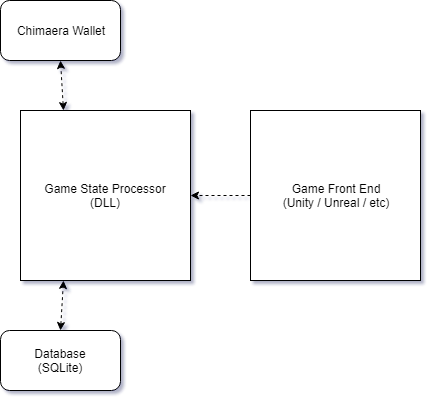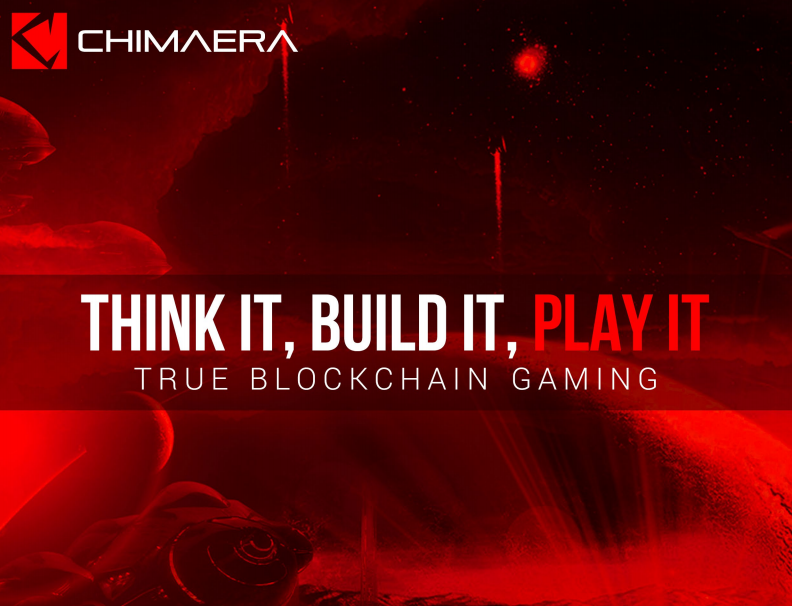We’re deep into development on Treat Fighter, and it has become pretty clear that this is an amazing technology. There are also a lot of misconceptions that we’ve heard talking to gamers and other developers. I’d like to take a moment to write about our experiences so far, correct some false assumptions, and look at the potential future of blockchain games.
First off, there are several existing blockchain games and recent ICOs (Initial Coin Offering– think Kickstarter for Cryptocurrency) related to blockchain gaming platforms. However, I haven’t seen any that are aiming to do what Chimaera does. Most of them are using cryptocurrencies as an in game currency or providing ownership of virtual items through the blockchain. Chimaera’s platform goes way beyond this. With Chimaera, developers can build decentralized massively multiplayer games.
My background is in building highly scalable game and web platforms. I was one of the first engineers at Etsy.com, a site that was getting a billion pageviews a month by the time I left. At Etsy, we were always frustrated that we couldn’t find people who had gone through the rapid scaling that we were in the middle of. We wanted people with that experience to guide us and help design solutions to our scaling problems. Our theory back then (2008) was that anyone who had been through successfully scaling a startup didn’t need to work any more. I think the landscape has changed a bit over the last 10 years and while it’s still difficult to find scalability experts with real world experiences, they’re out there and very expensive. Scaling is hard. There are technologies like AWS and other cloud providers which weren’t around in the early Etsy days, but it’s still a lot of work and a very specialized skillset. With Chimaera, you don’t need to think about 90% of that since there aren’t any servers. In many ways you can build games as if there were multiple players on the same machine, which cuts out a lot of the difficult parts of multiplayer.
How It Works
 The short version is that the game state is calculated from stored data on the blockchain which is accessed through the wallet (a piece of software that runs on your computer). As in all cryptocurrencies, the blockchain is distributed to everyone who is using the currency and thus everyone who is using the game. To get into a little more detail, each player is assigned a “name”. This is effectively their account and it’s tied to their cryptocurrency wallet. Players can send “name updates” to the blockchain which indicate a desired change to the game state. In fact, the game state as a whole isn’t really stored on the blockchain. Instead, it’s all deltas– add this, move that, change the other thing.
The short version is that the game state is calculated from stored data on the blockchain which is accessed through the wallet (a piece of software that runs on your computer). As in all cryptocurrencies, the blockchain is distributed to everyone who is using the currency and thus everyone who is using the game. To get into a little more detail, each player is assigned a “name”. This is effectively their account and it’s tied to their cryptocurrency wallet. Players can send “name updates” to the blockchain which indicate a desired change to the game state. In fact, the game state as a whole isn’t really stored on the blockchain. Instead, it’s all deltas– add this, move that, change the other thing.
Since only the delta of the state is stored on the blockchain, a process is required to keep track of the current state of the game. We’re calling this the Game State Processor or GSP (or maybe the Game State Engine– the name is still up in the air). The GSP loads all the name updates from the blockchain for everyone and processes them to store the current state of the game. The GSP runs on anyone’s machine who is playing the game. In our case, it’s part of the main game process. A key function of the GSP is to ensure that nobody is cheating. It has to throw out any name updates which don’t follow the game rules. So, I can’t spend 2000 crystals (in game currency) when I only have 1000. If I tried that, the GSP wouldn’t accept the update and nobody’s game state would make changes based on it.
Honestly, there’s an easy analogy here. The GSP is playing the role of the server. It knows what everyone is doing, and it validates input from them, throwing out anything that doesn’t abide by the rules.
There are some trade-offs of course. Every player has to keep a record of everything that’s happening in the game on their computer. The first time you play the game, it also has to read through all the blocks in the blockchain since the game started to build up the state. After the first run, the game will only need to sync up whatever happened while you were away. Fortunately, there are ways to mitigate the initial startup including distributing copies of the game state with the game or over the internet. Chimaera also plans a relay service where they would host either the blockchain, game state, or both. This would enable minimal or no syncing and also opens the platform to mobile devices and web based games.
Common Misconceptions
I’ve personally heard a lot of bad information about blockchain games. One of the most common things is that people think that running a blockchain game means that your computer will be using considerable CPU or GPU resources to “mine” the cryptocurrency. This is completely false. Mining Chimaera’s currency (CHI) and playing the game are two separate activities. You don’t need to have anything to do with mining to play the game. However, CHI works like other cryptocurrencies and does require people to mine it. As a player of the game, you don’t have to worry about this though. Let other people do it. They get their own rewards for doing so (free CHI).
Another misconception I’ve heard is that building a blockchain game is a lot more complex than a regular game and that there’s no point to having a server-less multiplayer game because servers exist and are already a thing. At Tricky Fast, we’re one of the first game studios to be using the Chimaera platform. There have certainly been hurdles and a steep learning curve, I won’t lie. However, Chimaera will be releasing a GSP framework that we’ve helped develop as open source as part of their SDK, and others will be able to build on it to create their own games. That’s exactly what we’re doing and our additions will also be open source. The GSP is really the tricky bit, but since Chimaera is providing the framework for it with our help, it is relatively easy to build the rest of the game. Chimaera is also working on an SDK and documentation which will further simplify things. Really, we’ve been a test case for the platform, and even so, our engineers are handling the complexity just fine. On the other hand, if we did Treat Fighter as a server based game, our development costs would easily triple due to needing to build a separate scalable server platform.
Finally, people have also commented that they don’t even know how to purchase cryptocurrency or to exchange Bitcoin for CHI. I’ll admit that when Treat Fighter goes live, this will still be a barrier to entry. On the flip side, there’s a relatively easy solution that Chimaera is planning to implement, which is providing an easy way to purchase CHI with regular currency from their platform or possibly even from within the games themselves.
The Future Of Chimaera

Our team was certainly a little skeptical of Chimaera when we started working on this project. We were very concerned that the blockchain would severely limit what sort of gameplay we could do. Looking at competitors, many of them can barely be called games. However, as we’ve become familiar with the platform, it’s opened up more game ideas, and we’ve already been brainstorming what our next game will be on the platform. Right now, it’s limited to asynchronous games, but Chimaera has a planned feature called Side Chains which will allow for real time games including MMORPGs. We’re certainly very excited about that, but even without it, we’ve come to see the power of the system. Our scope was time constrained for Treat Fighter, but without that limitation, there are many options for bigger games that we’ve been discussing internally.
On the flip side, once Side Chains are available, even something like an FPS or battle royale game would be amazing on the platform. If in game currency or items are sellable for CHI (which can be exchanged for real money), players could be monetarily rewarded for their skill in these games. e-Sports have become a big thing in recent years, and I believe that cryptocurrency backed games could push that movement even further. Plus, with the GSP, nobody will be able to cheat.
The big dream that I think a lot of people see in this technology is a shared user modifiable virtual world. Something like Minecraft or SecondLife, but completely decentralized and with a massive amount of players. Like SecondLife, people would flock to such an experience because of the money-making potential. One of the first big game projects I built was Multiverse3D. At various points in its life, it was a decentralized MMO where anyone could build their own part of the world. I think that Chimaera could be the best platform to bring this to life. It is still a ways off and would be a big undertaking, but it does seem possible on the Chimaera platform.
For more information about Chimaera, check out their website at https://chimaera.io








Pingback: Building Blockchain Games With Chimaera – CryptoNews – Cryptocurrency news, bitcoin, ethereum, blockchain, smart contracts April 13, 2018
[…] View Source […]
Pingback: Pre-sale complete — information for CHI owners | XAYA July 20, 2018
[…] http://www.trickyfast.com/2018/04/12/building-blockchain-games-with-chimaera/ […]